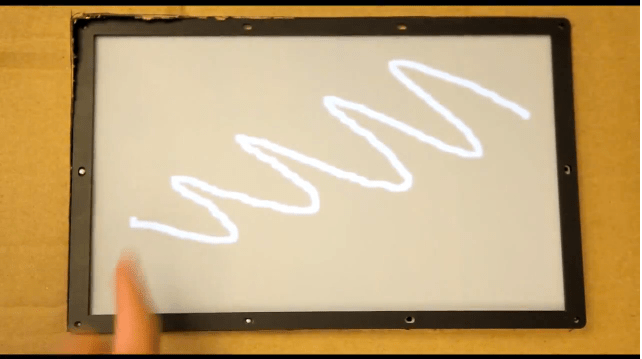As solid as modern touchscreens are, there’s very often an subtly apparent sense of disconnect when you try to use one. According to Paul Dietz of Microsoft’s Applied Sciences Group, it all comes down to latency — he notes average touchscreens have a latency of a 100ms, which yields a noticeable bit of lag between a user touching a screen and the screen displaying a reaction to it.
Sure, it’s totally usable, but it never really feels like you’re fully in control. If you drag an app across the iPad’s screen, for example, the icon will dance around your finger a bit as the display tries its best to keep up. That’s not good enough for Dietz and his team, as they have whipped up a demo of how things ought to be — unlike the 100ms delay of a regular touchscreen, the demo knocks that delay between touch and tracking down to 1ms flat.
The difference is staggering, especially when Dietz trots out the slow-motion footage. With the delay between touch input and screen response slashed by orders of magnitude, a device that sports the sort of super-low-latency Dietz envisions has the potential to feel far more (for lack of a better term) natural than its brethren. There’s zero delay when you slide a checker across a board, for example, and bringing that sort of instantaneous feedback to the many screens in our lives could help to bridge the gap between operating a bit of software and the feeling of interacting with objects.
Stylus-based interfaces would benefit greatly from this sort of tech. I spent a few brief moments playing with Samsung’s 10-inch Galaxy Note, and while the included S-Pen certainly did the trick, it was still jarring to see the line I was trying to draw following the pen rather than coming from it. (It took me a few tries to nail that TC logo, natch).
But here’s the thing: as cool as this stuff is, I can’t help but wonder if it’s an accomplishment best appreciated by nerds. Microsoft’s interest in this seems purely academic — they’re not, after all, in the business of stamping out displays. The touch mavens at Synaptics though showed off an impressively precise low-latency screen at MWC 2011, so the interest within the industry is definitely there.
Whether or not this sort of tech will ever make it to the mainstream is something else entirely. Cost of implementation is one potential issue, but I would imagine for something like this, a bigger question is whether or not the average consumer will care enough. A stylus-driven UI is one thing, but our standard, slower displays have been doing an adequate job with finger-based input for a while now. Do we really need a disruption in screen tech if what we have is good enough?
I say yes (I’m no fan of just “good enough”) but that’s really not for me to decide. I look forward to seeing if any manufacturers out there are willing to take the plunge on a low-latency screen like this, and I’m even more hopeful that people find they like how it feels.
